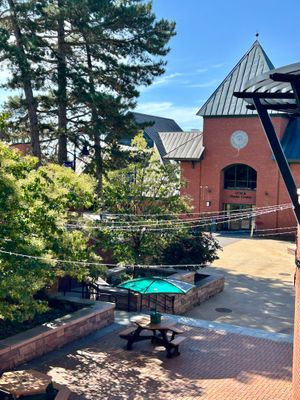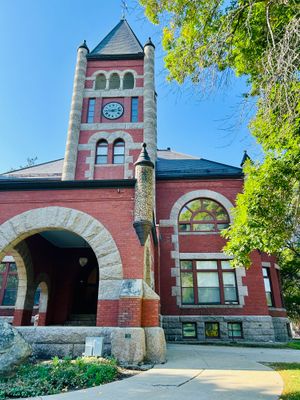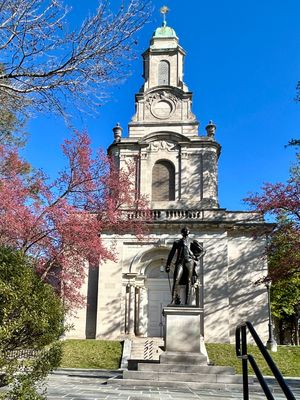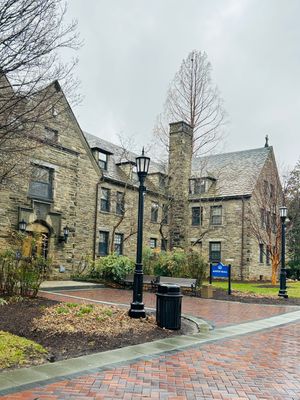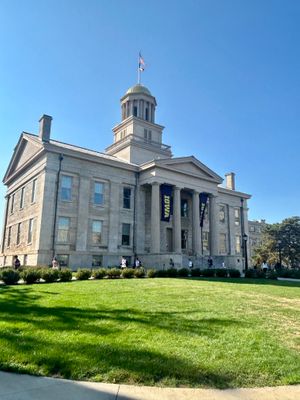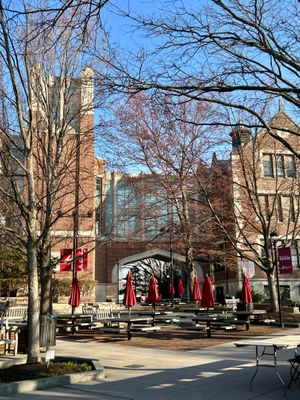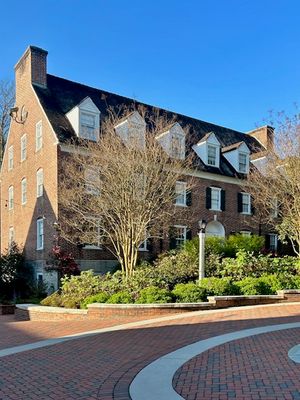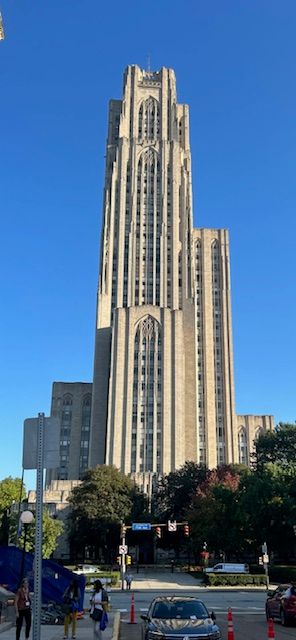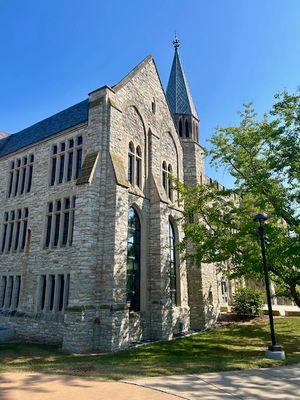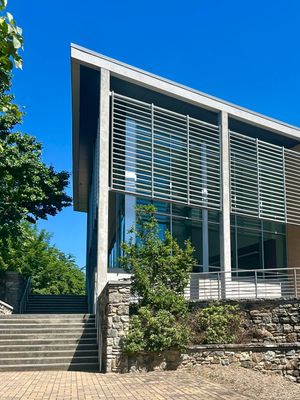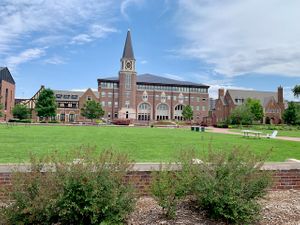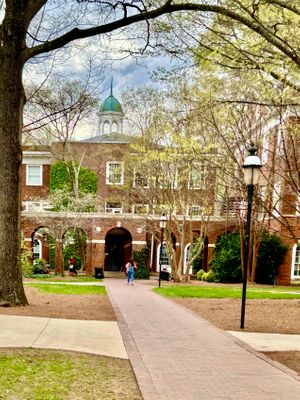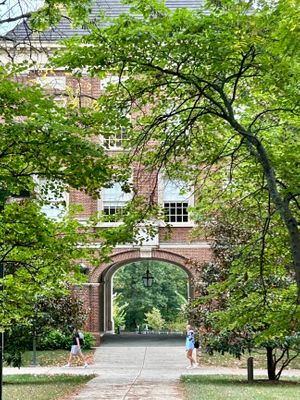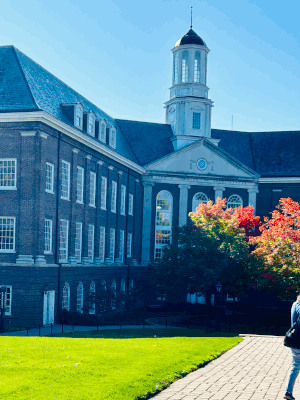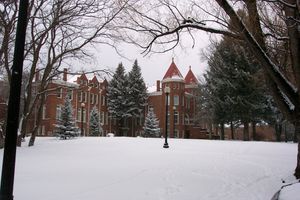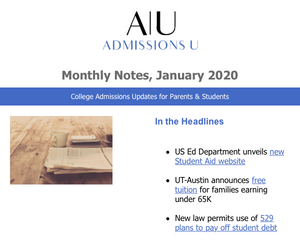NEWS & RESOURCES
The Latest College Admissions Updates
Is Your Teen College Ready?
Students can be college bound (they are following along the path, completing assignments and generally doing what they need to in school) without being college ready, which requires a whole different set of skills and maturity. The pandemic meant that most students were isolated from peers and teachers for long stretches, impeding growth in a number of areas. Colleges are reporting that the students arriving on campus are more anxious than ever. Here are some articles to help move your student from merely college-bound to college-ready, as well as signs that readiness may still be a while off for your particular student:
- From Grown & Flown, the 100 Essential Life Skills for Teens
- From USF, a different set of 10 Life Skills Every College Student Needs to Know
- More from young adult experts Grown and Flown: Advice for Assessing Your Student's Readiness for College
College Spotlight: Champlain College
The Area: Champlain College is perched on a hillside in a residential section of Burlington, Vermont, one of New England’s most charming and vibrant small cities and best college towns (the campus is adjacent to the bustling University of Vermont).
Burlington (population 45,000) is known for its artsy, eco-friendly vibe, full of local shops, cafés, and live music venues. The waterfront area is just a short walk away, offering bike paths, boat rentals, and open-air events. Outdoor enthusiasts have the Green Mountains for skiing and hiking within an hour. Montreal is about an hour and a half away, and Boston is just over three hours by car. Burlington International Airport is just 10 minutes from campus and offers direct flights to many major hubs.
The Campus/Students: The Campus/Students: Founded in 1878, Champlain College is a compact, picturesque campus, full of character and easy to navigate on foot. Many students live in Victorian-era mansions turned residence halls (fully modernized inside), but newer buildings blend well with the historical ones on the charming campus. Head to the top floor of the library for stunning views of the Adirondack Mountains and Lake Champlain, especially at sunset.
more5 Top Honors Colleges
What Are Honors Colleges?
If you’re a high-achieving student looking for a smaller, more personalized college experience within a larger university, an honors college might be the perfect fit. Honors colleges offer enriched academics, smaller discussion-based classes, priority registration, special housing, and close access to professors—all while giving you the resources, school spirit, and opportunities of a big university.
5 Strong Honors Colleges to Know
Barrett, The Honors College at Arizona State University Often ranked among the best in the nation, Barrett feels like its own mini-campus with residence halls, dining, and classrooms. Students benefit from small honors seminars, a required thesis, and incredible access to research and internships across ASU’s vast network—including in downtown Phoenix and beyond.
Clark Honors College at the University of Oregon CHC students dive into discussion-based classes capped at around 20 students, taught by top professors (not grad students). They’re encouraged to explore across disciplines, with lots of support for research and creative projects. The vibe is collaborative and intellectual, all set in Eugene’s lively, outdoorsy college town.
moreHow to Research a College's Alumni Network
A college’s alumni network can make a big difference in job outcomes, internships, mentoring, and long-term career support. But since schools rarely publish a single “alumni network strength” score, you’ll need to piece it together from several sources. Here are some ways to get started:
🔍 1. Check Alumni Engagement and Giving Rates
Alumni giving rate is a simple proxy for engagement — it measures the percentage of alumni who donate back to the school.
A higher rate (typically 15–25%+) suggests alumni feel loyal and connected.
You can find this in the school’s Common Data Set (Section H) or on U.S. News and IPEDS.
Look at how the college promotes alumni events, reunions, and volunteer opportunities — active outreach often signals strong ties.
💼 2. Use LinkedIn and Career Platforms
On LinkedIn, go to the college’s page and click “Alumni.” You can:
See how many alumni are active on LinkedIn (a rough size indicator).
Filter by industry, location, and employer to gauge their professional reach.
Check for clusters in certain cities or fields (e.g., lots of alums at Google, or a heavy concentration in Boston or D.C.).
more
College Spotlight: University of New Hampshire
The Area: Set in Durham, a classic New England college town, the University of New Hampshire (UNH) offers the best of the region in one place. Students are just 15 minutes from the beach, with 15 miles of accessible seacoast, and are within an hour of the White Mountains for skiing and hiking. The historic port city of Portsmouth—well known for its restaurants, waterfront, and cultural events—is about 20 minutes away. Boston is just an hour away by car, and the Amtrak Downeaster stops right on campus, providing students with easy train access to the city for internships, concerts, and other fun activities. Manchester, the largest city in New Hampshire, and Concord, the Capital, are each just about 45 minutes away.
The Campus/Students: UNH’s campus is beautiful and highly walkable, blending historic red-brick buildings with new, modern facilities. With Durham’s local cafés, restaurants, and shops just a 5-minute stroll from campus, students feel connected to town life. The grounds are well-maintained, and the feel is quintessentially collegiate. The university enrolls about 11,000 undergraduates and 2,500 graduate students, drawing students from 49 states and 74 countries. 60% of students are from out of state, but diversity on campus is notably lacking.
moreTracking College Trends: Alternative Pathways
As college admissions grow increasingly competitive, many schools are offering alternative pathways as a way to manage enrollment numbers and diversify their student populations. Here are some popular pathways:
- Spring Admission: Students begin college in January rather than August or September. This allows colleges to balance enrollment and gives students time for travel, internships, or work experience.
- Semester Abroad or Away Programs: Some students are admitted with the condition that they spend their first semester studying abroad (in places like Rome, London, or Madrid) or at a satellite campus or partner institution. Boston University's First-Year Abroad and Northeastern's NU.in programs are popular examples.
- Satellite or Alternate Campus Enrollment: Universities with multiple campuses may offer admission to a non-primary location for the first year or two. For example, Penn State students may start at one of 19 commonwealth campuses before transferring to the University Park campus. New York University offers NYU Shanghai and NYU Abu Dhabi as first-year entry points.
- Transfer Pathways: Some colleges offer guaranteed or conditional transfer admission. This means a student starts at a partner community college or another institution and transfers after meeting specific academic requirements. Schools like USC and Cornell use these structured pathways to fill sophomore seats with strong candidates.
Understanding "Fit to Major" at UT Austin
When you apply to UT Austin, you don't just apply to the university—you also apply directly to a specific major. That's where the idea of "fit to major" comes in. Admissions officers aren't only asking, "Can this student succeed at UT?" They're also asking, "Does this student make sense for the major they've chosen?"
How to Show Fit to Major
✅ Start early in high school
If you already have an idea of your intended major, begin exploring it in meaningful ways:
- Take strong, related coursework (AP/IB classes, electives, or dual enrollment).
- Join clubs, activities, or competitions that connect to your field.
- Look for internships, summer programs, or personal projects that show initiative.
✅ Use the Expanded Résumé
UT's expanded résumé is your opportunity to outline your accomplishments and explain how they relate to your intended major. Don't just list activities—highlight the impact and the skills gained. Admissions officers want to see growth and commitment over time.
✅ Connect it all in your essays
Your essays explain the why: why you're drawn to this field, what you've done to prepare, and how UT is the right place for your next step.
moreCollege Spotlight: Lafayette College
The Area/Town: Lafayette College is perched on College Hill in Easton, Pennsylvania, located in the Lehigh Valley near the Delaware River. Approximately 75 minutes from Philadelphia and 90 minutes from New York City, Easton offers Lafayette students a unique blend of small-town charm and fairly easy access to major urban opportunities. The town (walkable from campus, though inclines are included!) features a revitalized downtown with art galleries, independent shops, local restaurants, a year-round farmers market, and the Crayola Experience. The college's deep roots in the city mean students frequently engage in community-based learning and service projects.
The Campus/Students: Lafayette's campus is gorgeous! From Gothic-style academic buildings to modern residence halls and sweeping green spaces, the 340-acre campus is a mix of traditional and contemporary. About 93% of students live on campus in this highly residential, walkable community, and housing is guaranteed for four years. With 2,700–2,800 students (all undergraduates), Lafayette offers a personalized and close-knit experience.
Students are both spirited and multifaceted: About a quarter of the student body competes as Division I athletes in the Patriot League, and there are dozens of co-curricular clubs and organizations to get involved in—from theater to robotics to social justice. Lafayette's long-standing tradition of service is alive and well, with 75% of students participating in community service during their time on campus. Students have a voice here—whether it's shaping campus policies or launching new initiatives.
moreHidden Gems for Engineering Majors
Engineering is one of the most selective majors, making it essential that prospective students include colleges with reasonable admissions chances on their list. Thankfully, there is no shortage of fantastic programs that fit the bill. Here are just a few to consider in your college search:
🚀 Co-ops & Real-World Experience
- University of Cincinnati – Famous for inventing the co-op model, UC guarantees students real-world, paid work experiences built right into their engineering degree. By graduation, students will have multiple semesters of job experience.
- Iowa State University – One of the largest engineering programs in the Midwest, with endless internships and co-ops. Employers come here looking for engineers.
🔬 Hands-On, Project-Based Learning
- Worcester Polytechnic Institute (WPI) – Students dive into projects from freshman year, tackling real-world problems in teams. It’s like engineering training wheels—but with actual impact.
- Clarkson University – A smaller school where students roll up their sleeves and get close mentorship. Great for those who want practical experience in civil, mechanical, and environmental engineering.
How to Get Accommodations in College
The process for obtaining accommodations in college differs from what families may be accustomed to under high school IEPs or 504 Plans.
1. Understand the Law
In college, accommodations are covered under the Americans with Disabilities Act (ADA) and Section 504 of the Rehabilitation Act. Unlike high school, where schools are required to identify students who need support, in college, students must self-advocate and initiate the process.
2. Gather Your Documentation
Most colleges require recent documentation that outlines:
- A diagnosed disability (learning, physical, psychological, etc.)
- How the disability affects learning or daily functioning
- Recommendations for appropriate accommodations
This may include a psychoeducational evaluation, medical records, or a letter from a licensed provider. Some colleges accept a current IEP or 504 Plan as supporting documentation, but not always as the primary source.
3. Contact the College's Disability Services Office
Every college has a Disability Services (DS) or Accessibility Office. Students should:
- Visit the office's website for application procedures (colleges will generally outline what documentation is required)
- Submit documentation before the semester starts (earlier is better!)
- Schedule a meeting to discuss their needs
High School Grade Inflation & College Admissions
High school grades are climbing—but not always for the right reasons. From 2010 to 2021, the average GPA increased from 3.17 to 3.36, a notable rise over just over a decade. By 2022, nearly 90% of students were earning A's or B's in their core subjects. But all this grade inflation is making it harder for colleges to tell which students are truly ready for college-level work.
What Is Grade Inflation?
Grade inflation happens when students receive higher grades than their performance objectively warrants. This may result from schools trying to boost student confidence, meet parent expectations, or adjust for pandemic-related disruptions. Some examples: schools letting students turn in missing work for full credit at the end of marking periods and redoing graded work for higher scores, plus less intensive writing assignments and requiring few, if any, long papers.
The result? More students with top GPAs, but not necessarily stronger academic skills.
How It Affects College Admissions
With so many applicants earning high grades, GPA alone no longer tells the whole story. Admissions offices are having to look deeper:
- Course rigor is under the microscope. Colleges want to know if students challenged themselves with AP, IB, honors, or dual-enrollment classes.
- Essays and letters of recommendation are more important than ever to understand a student's character, motivation, and growth.
- Extracurricular involvement helps colleges see who a student is beyond academics—what they value and how they engage with the world.
5 Colleges with Top Co-op Programs
What Are College Co-op Programs?
Co-op (short for cooperative education) programs combine classroom learning with paid, full-time work experience in a student's field of study. These programs are designed to give students a head start on their careers by allowing them to apply what they've learned in real-world settings—often multiple times before graduation. Co-ops differ from internships in that they are typically longer, more structured, and integrated into a student's academic schedule. Students often alternate between semesters of classes and full-time employment.
Northeastern U in Boston gets a lot of attention, but there are lots of other amazing colleges with co-op programs to take a look at, including:
University of Cincinnati
UC prides itself on being the first college in the nation to offer co-op education. Generally, students spend five years at UC, taking classes full-time during the first and final years, with co-op programs alternating semesters throughout the other years. While only required for some majors, all students are eligible and encouraged to participate in co-op, and 100% of students engage in experiential learning of some kind. The university partners with thousands of employers, and students earn an average of $10,000–$12,000 per semester while gaining valuable experience.
moreCollege Spotlight: Villanova University
The Area: Nestled in the heart of the posh Main Line suburbs, Villanova is about 12 miles (30 minutes by train or car) from downtown Philadelphia, offering a safe, traditional campus with easy access to one of the nation’s largest and most historic cities. The region is known for its tree-lined streets, stately architecture, and sense of community, while Philly’s museums, music venues, restaurants, and professional sports are just a few miles away. It’s a 20-minute ride to the Philadelphia International Airport, and proximity to NYC (less than 2 hours) and D.C. (about 2.5 hours) make the location even more appealing in terms of access to major cities.
The City: While Villanova is quiet and residential, the close connection to Philadelphia offers students plenty of off-campus opportunities for culture, internships, and fun. The regional rail system SEPTA has two stops directly on campus, giving students easy access to Center City and beyond. With Philadelphia’s reputation as a hub for healthcare, business, law, and nonprofit work, students find it easy to connect what they learn in class to the real world. The city also adds to the school’s strong spirit, especially during March Madness—Villanova men’s basketball is a Philadelphia institution.
moreCollege Spotlight: University of Iowa
The Area: Situated along the Iowa River and surrounded by rolling countryside, Iowa City is two hours from Des Moines and four hours from Chicago. Students traveling from further afield can drive 20ish minutes to Cedar Rapids and the Eastern Iowa Airport, which has direct flights to LA, Denver, Dallas, D.C., and Nashville, to name a few. But don't let the surrounding cornfields fool you–Iowa City is a bustling small city and a true college town.
The City: The campus blends directly into downtown Iowa City (pop. 76,000), and students can walk from class to coffee shops, bookstores, restaurants, and even a two-story Target within minutes. It's a compact, charming city that's easy to navigate on foot—tour guides even caution against bringing a car due to limited parking. Regularly ranked on "best college towns" lists, as well as being a designated UNESCO City of Literature, Iowa City has a vibrant literary and cultural scene (hosting numerous festivals and performances year-round) and the energy of a university hub.
The Campus/Students: Bounded clearly by the Iowa River and downtown, Iowa's attractive campus is very accessible—you can walk across it in about 10 minutes. Buildings are a mix of Greek Revival the state's original capital building is a centerpiece on campus) and modern. Housing varies from new and "hotel-like" to older and more traditional; students have 20+ living-learning community housing options to choose from, as well.
moreWhen and How to Report AP Scores
Most colleges do not consider AP scores in the admissions process, but showing mastery of the AP material with a high score can help colleges assess a student's readiness for college-level work (some colleges will even accept them in lieu of SAT/ACT scores).
Keep in mind that your grades and performance in AP classes throughout the year always matter, and a high AP score will not "erase" poor performance in a class.
What Is a Good AP Score? It differs by college--some colleges will award college credit for a score of 3 (the lowest passing score) or higher, while others may only give credit for a score of 4 (or 5). Colleges generally post this information on their websites so you can see (before you potentially self-report scores) what scores a particular college values.
When to Report AP Scores
- You can self-report your AP scores on college applications (Common App, Coalition, etc.).
- Only report scores you want to (unless you are applying to one of the minuscule number of colleges that requires all test scores at the time of application)
- Official AP score reports are typically only required after you commit to a college (senior year). This is when you should send official scores via the College Board for potential college credit or placement.
Major Matters
If you're stressing about picking the "perfect" college major because you think it'll lock in your entire future—take a deep breath. Here's the truth: your major is not your career, and it doesn't define who you are or what you'll do forever.
So, What Is a Major, Really? A college major is just a subject you choose to focus on during your time in college. It gives you some depth in one area—like biology, history, computer science, or English—but it's not a life sentence. It's more like a launchpad.
Majors Don't Equal Jobs Let's bust a myth: Most people don't end up working in a field that directly matches their major. History majors become lawyers, philosophy majors go into tech, and English majors end up in marketing, business, or even coding. Why? Because employers care more about your skills, experience, and how you think—not just the name of your degree.
You're Gonna Grow (a Lot) The person you are at 17 is not the person you'll be at 22 or 30. You'll discover new interests, strengths, and goals over time. College gives you the freedom to explore, change your mind, and try different paths. That's not a failure—it's part of the process.
moreCollege Spotlight: Muhlenberg College
The Area/Town: Muhlenberg College is about 10 minutes from downtown Allentown, Pennsylvania's third largest city (pop. 125,000). In Allentown, students will find a growing restaurant scene, cafes, and cultural venues like the Allentown Art Museum. The area is undergoing growth in the business and innovation sectors, providing internship and networking opportunities.
Muhlenberg College is also 60 miles from Philadelphia and about two hours (95 miles) from New York City–a huge plus for the college's numerous theater students. Students seeking to escape into nature don't have to travel far to find parks, trails, and the Pocono Mountains.
The Campus/Students: Muhlenberg's 82-acre, red-brick campus blends traditional (mostly gothic) charm with modern facilities. It includes a 40-acre biological field station and wildlife sanctuary, as well as a 64-acre arboretum and updated science centers. A newly constructed building, the Fehy Commons for Public Engagement and Innovation, has received numerous sustainability accolades, and construction is currently underway for a new building that will house the welcome and career centers, as well as the alumni connections office and event space. With approximately 2,000 undergraduates and a required four-year residential policy, students enjoy a tight-knit, inclusive community. Students are known to be friendly (very friendly!) and hard-working, and the school emphasizes a student experience centered on the philosophy of "Challenge, Support, Impact, Belong"—which comes to life in the classroom and campus culture.
moreCollege Spotlight: Salem College
The Area: Located in Winston-Salem, North Carolina, Salem College sits in the heart of a vibrant mid-size metro area, known for its history, arts scene, and growing innovation sectors. With easy access to both the Blue Ridge Mountains and the beaches of North Carolina, outdoor enthusiasts can find plenty of opportunities for hiking, kayaking, and exploring. The campus is approximately 30 minutes from the Piedmont Triad International Airport, and about an hour and a half from the larger Raleigh-Durham airport.
The Town: Salem College is situated in the historic Old Salem district with the campus virtually indistinguishable from the abutting Salem Museum (an active living history museum). The larger city of Winston-Salem, with a population of over 250,000, provides students with ample entertainment, dining, and internship opportunities. From coffee shops and local boutiques to art galleries and music venues, students can enjoy both the quaint charm of Old Salem and the bustling energy of downtown Winston-Salem, which is just a short walk or drive away.
The Campus/Students: Founded in 1772, Salem College is the oldest continuously operating educational institution for women in the United States and was originally the sister school of Davidson College. The campus also houses Salem Academy, a day and boarding school for girls. The picturesque campus is compact, historic (records show George Washington visiting the campus), and beautifully maintained, abutting downtown Winston-Salem.
moreCollege Merit Aid Myths, Busted!
When it comes to paying for college, many families hope that merit aid (this is gift money awarded by colleges that does not need to be repaid AND is generally not based on financial need) and outside scholarships will significantly reduce costs. However, there are several myths surrounding merit aid that can lead to unrealistic expectations. Here are a few:
Myth 1: High Achieving Students Always Get Full Scholarships From Colleges
Reality: While colleges do award merit-based scholarships to students with strong academics, full-ride scholarships are rare. Most merit aid covers only a portion of tuition, and some colleges do not offer merit aid at all, focusing instead on need-based financial aid. And with high school grade inflation at an all-time high, a report card filled with A’s is more common than ever.
Myth 2: Merit Aid and Scholarships Are Only for Straight-A Students
Reality: While GPA is important for many merit awards, many colleges consider other factors such as leadership, extracurricular activities, community service, and special talents. Some schools may offer merit aid based on specific interests, career goals, geographic location, or any other factor that makes a student appealing to the college. Ultimately, merit offers are a discounting method colleges use to entice students to attend their college over other options.
moreCollege Spotlight: University of Pittsburgh
The Area: The University of Pittsburgh ("Pitt") is located in the heart of the city's bustling Oakland neighborhood, just three miles from downtown Pittsburgh. The area is a vibrant mix of urban life, green spaces, and cultural institutions, including museums, theaters, and medical centers. With its position on a hill, many parts of campus offer great views of the city skyline and surrounding hills.
Students have access to an array of coffee shops, restaurants, and stores within walking distance, and the city's public transportation system allows for easy exploration of Pittsburgh's diverse neighborhoods, riverside trails, and professional sports venues (Fun fact: Pittsburgh is the only city where all the professional sports teams wear the same colors). Carnegie Mellon and Duquesne University are other nearby colleges.
The Campus: Pitt's main campus has a mix of historical architecture and modern facilities. The centerpiece is the 42-story Cathedral of Learning, an iconic neo-Gothic tower that houses classrooms, study spaces, and the Nationality Rooms, which represent cultures from around the world.
Students will find a mix of green spaces, including Schenley Plaza and the larger Schenley Park adjacent to campus, so nature is not far away. Recent additions like the Petersen Events Center, a hub for athletics and student activities, and the state-of-the-art Life Sciences Complex reflect the university's investment in infrastructure.
moreIntroduction to the Game Design Major
A Game Design major is perfect for students passionate about creating interactive digital experiences. This field blends art, storytelling, programming, and game mechanics to develop engaging video games. Students in this major typically study game development, animation, coding, user experience (UX), and narrative design, often working in teams to build playable projects. With the gaming industry growing rapidly, careers in game design can range from game designer and programmer to level designer and producer.
Some Top Undergraduate Game Design Programs in the U.S.
- University of Southern California (USC)
- University of Utah
- DigiPen Institute of Technology
- Rochester Institute of Technology (RIT)
- New York University (NYU) – Game Center
- Savannah College of Art and Design (SCAD)
- Michigan State University
- Northeastern University
- Drexel University
- Columbia College Chicago
The Benefits of a Large Research University for Pre-Med Students
Choosing the right college is a big decision, especially if you're on the pre-med track. While smaller colleges offer their own advantages, attending a large research university can provide unique benefits that help set students up for success in medical school and beyond. If you're considering a big university for your pre-med journey, here are some key reasons why it might be the right choice for you.
1. Access to Cutting-Edge Research Opportunities
Medical schools value applicants with research experience, and large universities typically have well-funded research programs in fields like biology, chemistry, neuroscience, and biomedical engineering. With major grants and faculty conducting groundbreaking studies, undergraduates often have the chance to get involved in research labs early in their college careers. Hands-on lab experience can give you a competitive edge when applying to medical school.
2. Abundant Clinical and Volunteer Experiences
Large research universities are often located near major hospitals, medical schools, and healthcare facilities. This proximity allows pre-med students to access internships, shadowing opportunities, and volunteer positions in clinical settings. These experiences are crucial for demonstrating a commitment to medicine and understanding patient care before applying to medical school.
moreThe Benefits of a Smaller College for Pre-Med Students
If you're a high school student considering a future in medicine, you've probably heard that big research universities are the best choice for pre-med. While large institutions have their advantages, smaller colleges can offer a unique set of benefits that might actually give you an edge when it comes to medical school admissions. Here's why a smaller college might be the perfect place to launch your pre-med journey.
1. Closer Relationships with Professors
Classes are typically smaller at smaller colleges, meaning you won't be just another face in a huge lecture hall. This allows you to build meaningful relationships with your professors, who often double as your advisors and mentors. These connections can lead to stronger recommendation letters, better research opportunities, and valuable guidance throughout your pre-med path.
2. More Personalized Pre-Med Advising
Many small colleges offer dedicated pre-health advising programs that give students individualized attention. Instead of competing with hundreds (or even thousands) of other pre-med students, you may receive more tailored support when it comes to course selection, MCAT prep, clinical experiences, and medical school applications.
more5 Summer Activities for Prospective Engineering Majors
Many top engineering programs are highly competitive, and admissions officers look for students who demonstrate both a strong academic background and a clear passion for the field. While high grades and test scores in math and science are important, many colleges also want to see students actively engaging in engineering-related activities before they apply. Hands-on experience, problem-solving skills, and a demonstrated interest in engineering can help set you apart from other applicants.
If you're a high school student considering an engineering major, spending your summer exploring the field can strengthen your application and give you a head start on essential skills. Here are five great summer activities to help you build experience and show colleges that you're a great fit for an engineering program:
1. Engineering Summer Programs Participate in pre-college engineering programs at universities (e.g., MIT’s Engineering Experience, Johns Hopkins’ Engineering Innovation). These programs offer hands-on learning in robotics, aerospace, mechanical, or electrical engineering.
2. Internships or Research Opportunities Look for local engineering firms, government agencies, or university labs that offer internships or research assistant positions. Even shadowing an engineer for a few weeks can provide valuable insight into the field.
moreCollege Spotlight: St. Olaf College
The Area: St. Olaf College is in Northfield, Minnesota. Located 45 minutes south of Minneapolis, students have relatively easy access to the cultural and professional opportunities of a major metropolitan area while enjoying the tranquility of a small-town setting. The area offers ample opportunities for outdoor activities like hiking, biking, and skiing.
The Town: Northfield, often described as a Hallmark movie-like town, is a picturesque town of about 20,000 residents, known for its charming downtown that features a few streets of quaint shops, restaurants, and a vibrant community atmosphere. Students enjoy walking into town to explore local eateries and coffee shops and participate in community events like farmers' markets and live music.
The Campus/Students: St. Olaf's 300-acre campus is celebrated for its stunning natural surroundings and sustainability efforts, highlighted by a windmill that generates about one-third of the campus's energy. The campus architecture combines traditional collegiate Gothic with modern elements, and every building--including dorms--features a piano, reflecting the college's deep-rooted commitment to the arts and music.
moreThe Hardest (and Easiest) AP Classes
Advanced Placement (AP) classes are considered more rigorous than standard high school classes because they are designed to be college-level courses. Still, there are difficulty levels even within the AP category. A couple of important notes about choosing AP courses before you keep reading:
- There is no definitive guide to ranking the difficulty of AP courses.
- The rigor of an AP class can depend on the individual student's background, strengths, and interests. What may be a challenging class for one student may be easier for another.
- An AP class's rigor can vary from school to school and from teacher to teacher.
That said, some AP classes are consistently noted to be among the most challenging coursework available to students.
The most difficult AP classes typically cover complex subject matter (often requiring students to be already advanced academically in a discipline), require extensive reading and analysis, and demand high critical thinking and problem-solving skills. These classes often have a heavy workload and require significant time and effort outside of class to keep up with the pace of the course. Some examples of AP classes that students often consider to be the most rigorous include:
more5 Summer Activities for Prospective Business Majors
Here are five summer activity ideas for high school students interested in majoring in business:
- Internship at a Local Business: Seek out internships with local businesses, startups, or non-profits--they can provide hands-on experience in business operations, marketing, or finance while helping students build professional networks.
- Entrepreneurship Project: Start a small business or a side hustle. This could be as simple as a lawn care service, private sports coaching, or a tutoring business. Students will develop skills in planning, management, and customer service.
- Business Competitions and Camps: Participate in business competitions or attend summer camps focused on entrepreneurship or business. Many universities and organizations offer programs that include workshops, mentorship, and pitching opportunities.
- Online Business Courses: Enroll in online courses related to business fundamentals, such as accounting, economics, or marketing. Platforms like Coursera, Udemy, and Khan Academy offer free or low-cost courses that can enhance students' understanding of business concepts.
- Shadowing a Business Professional: Arrange to shadow a business professional, such as a manager, accountant, or marketer, for a week or more. This experience provides insights into daily business operations and career paths in the business world.
10 New Year's Resolutions for High School Students
- Get More Sleep: Prioritize at least 7-8 hours of sleep each night to improve focus, energy, and overall health.
- Build Strong Relationships with Teachers: Spend time getting to know your teachers by attending office/tutoring hours and participating in class to gain valuable mentorship and future recommendation letters.
- Read More: Commit to reading a mix of fiction and non-fiction books to expand your knowledge, improve vocabulary, and enhance critical thinking skills.
- Stay Organized: Use planners, digital calendars, or apps to keep track of assignments, deadlines, and extracurricular activities, reducing stress and staying on top of responsibilities.
- Try Something New: Step out of your comfort zone by joining a new club, taking up a hobby, or volunteering, which can lead to new passions and experiences.
- Give Back: Engage in community service or volunteer work to develop empathy, leadership skills, and a sense of social responsibility while positively impacting others.
- Research Colleges: Explore different colleges and universities to find the best fit for your academic and personal interests.
- Prioritize Self-Care: Focus on overall well-being by incorporating regular exercise, a balanced diet, mindfulness practices, and activities that promote mental health, such as meditation or journaling.
- Practice Time Management: Learn to effectively balance schoolwork, extracurricular activities, and personal time to reduce burnout and enjoy a well-rounded high school experience.
- Reflect on Goals: Regularly assess your personal and academic goals, adjusting them as needed to stay motivated and on track for college readiness.
How to Sign Up for College Visits
Visit the College Website
- Go to each college's official website.
- Look for sections like "Admissions," "Visit Campus," or "Prospective Students."
- Many schools have online calendars where you can see tour dates, open houses, and special events.
Create an Account or Register
- Some colleges require you to create an account on their admissions portal to register for visits.
- Follow the instructions to sign up for a campus tour, information session, or open house.
Contact the Admissions Office
Call or email the admissions office directly if you can't find the information you need online. They'll help you book a tour and answer any questions.
Plan Ahead
- Schedule visits early, especially for popular colleges. Fall and spring dates fill up quickly!
- Consider visiting on weekdays when classes are in session to get a realistic feel of campus life.
- If tours are full when you can visit a campus, you should still pop by the admissions office--ask for a map, say you are going on a self-guided tour, and fill in the contact card. Sometimes, a student will be available to take you on a tour, or an admissions rep will be available to say hello.
Beyond Tuition: Creative Ways to Use 529 Funds
When people think of 529 savings plans, the first thing that comes to mind is saving for college tuition. While that's a primary benefit, 529 funds are much more versatile than you might realize. Changes to legislation have expanded their potential uses, making them a powerful tool for families planning for education costs. Here are some of the ways you can use 529 funds beyond traditional tuition payments.
K-12 Education Expenses Thanks to changes in tax laws, 529 plans can now be used to pay for up to $10,000 per year in tuition for elementary, middle, or high schools. This applies to private, public, and religious institutions.
Apprenticeship Programs If your child opts for a hands-on learning path, 529 funds can cover costs related to qualified apprenticeship programs. These programs must be registered with the U.S. Department of Labor, but eligible expenses can include tuition, fees, books, and required equipment like tools.
Student Loan Repayment A newer provision allows up to $10,000 per beneficiary (and $10,000 for each of their siblings) to be used for student loan repayment.
Room and Board 529 plans can be used for on-campus housing and some off-campus arrangements, provided the expenses don't exceed the college's published cost of attendance.
moreCollege Spotlight: Macalester College
The Area: Macalester College is located in a picturesque residential neighborhood in St. Paul, the capital city of Minnesota. Just minutes from the vibrant downtown areas of both St. Paul (4 miles) and neighboring Minneapolis (6 miles), students benefit from the amenities of a dynamic urban setting while enjoying the charm of a cozy college town.
Known as the Twin Cities, the area offers access to cultural institutions, thriving arts scenes, professional sports, and countless dining and entertainment options. Outdoor enthusiasts will appreciate the abundance of parks, lakes, and trails, with year-round opportunities for activities like biking, cross-country skiing, and kayaking.
Macalester's immediate surroundings reflect its urban-meets-residential setting. Grand Avenue, easily walkable from campus, is lined with plenty of independent shops, cafés, and restaurants for students to explore.
The Campus: Macalester's beautiful, contained 53-acre campus is known for its blend of classic Collegiate Gothic architecture and modern facilities (with red brick dominating the aesthetic). Students can easily get from one end of campus to another along tree-lined pathways, and there is plenty of green space for students to enjoy (weather permitting since this is Minnesota!).
moreReasons to Love Rolling Admissions
Colleges with rolling admissions evaluate applications as they are received rather than waiting until a set deadline to review all applications. These schools typically have a wide application window, sometimes stretching from early fall to late spring. Admissions decisions are often issued within a few weeks, allowing students to know their status much earlier than traditional decision deadlines. Some of the benefits include:
Early Answers, Less Stress Receiving an acceptance early in the application cycle can alleviate anxiety. Knowing you're admitted to at least one college allows you to focus on other applications with greater confidence.
Flexible Deadlines Rolling admissions colleges often accept applications long after traditional deadlines have passed. This flexibility is helpful if you need to adjust your plans or apply to additional schools later in the cycle.
Increased Admission Chances Applying early to a rolling admissions school may boost your chances, as spots are filled on a first-come, first-served basis. This is particularly beneficial for competitive programs within these colleges.
Building a Balanced College List A well-rounded college list includes a mix of reach, target, and likely schools. Rolling admissions schools are often ideal as "target" or "likely" options, offering reliable choices while keeping your options open.
moreUnderstanding In-State Residency for College Tuition
For students and parents planning for college, figuring out how to reduce costs is at the top of many families' minds. One way to do this is by qualifying for in-state tuition, which is generally much lower than out-of-state rates at public colleges and universities. However, establishing residency and getting in-state tuition is nearly impossible in most states (which rely on those higher out-of-state tuition dollars to operate). Here are some general guidelines and information about reciprocity programs, which have their own set of restrictions.
General Requirements for In-State Residency
While the specifics vary by state, most states consider factors like residency duration, financial independence, and primary intent to reside. The steps typically include:
Residency Duration: Living in the state for a minimum period (usually 12 consecutive months).
Demonstrating Intent: Obtaining state-issued IDs, registering to vote, and paying state taxes can help prove you're a resident for reasons beyond education.
Financial Independence: Many states require students to show they are not financially dependent on parents living out-of-state.
more
College Spotlight: Drake University
The Area: Drake University is located just a few miles from downtown Des Moines, Iowa. The mid-sized capital city has a thriving arts scene, many parks, and a growing culinary landscape. Students can easily access downtown Des Moines in less than 10 minutes by car, bike, or the city’s reliable public transportation system. The airport is a short 15-minute drive away, and the immediate campus area, a historic residential neighborhood, is surrounded by quaint shops, coffee spots, and eclectic dining options. Outdoor lovers can take advantage of nearby trails, lakes, and outdoor spaces, all within a short drive.
The Campus: Drake’s 150-acre campus is a blend of traditional and modern architecture. Historic buildings mix nicely with newer facilities like the LEED Gold-certified Science Connector Building. With tree-lined paths and large open green spaces, Drake offers a peaceful, walkable environment. Known for its close-knit community, Drake students enjoy numerous outdoor study spots and plenty of bike racks. Recent upgrades to the campus include a state-of-the-art STEM complex and modern residence halls. The central location means students can experience traditional campus life with easy access to city amenities.
moreCollege Spotlight: UNC Asheville
The Area: The mountain city of Asheville, NC, is in the Blue Ridge Mountains, a little more than one hour from Greenville and roughly two hours from both Knoxville, TN, and Charlotte, NC. With a population of just under 100,000, the thriving and picturesque small city is a haven for artists, musicians, foodies, and outdoor enthusiasts. The River Arts District, along the French Broad River, is a popular destination, as is the bustling downtown area, filled with local eateries, galleries, and eclectic shops. Students will also find familiar retailers like Target, Trader Joe’s, and Whole Foods among the home-grown shops.
Asheville’s location among the gorgeous Blue Ridge mountains cannot be overlooked. Hiking, climbing, kayaking, and white water rafting are easily accessible; five ski resorts are within a one- to three-hour drive. The historic Biltmore Estate is a short drive from downtown, and nearby towns of Black Mountain and Weaverville are also popular vacation spots.
The Asheville Regional Airport (16 miles from the campus) offers non-stop flights to 27 destinations, including Austin, Orlando, Newark, Baltimore, Denver, and Chicago, to name a few.
moreCollege Spotlight: University of Denver
The Area: The University of Denver (known as DU) is located 5 miles south of downtown in a comfortable, residential part of the city. Students can utilize an on-campus light rail stop and be downtown in 15 minutes. The Rocky Mountain vistas make for some amazing views on campus, and a drive to the mountains (and major ski areas) takes approximately an hour. The uniquely situated campus offers a unique blend of urban access and amenities with unparalleled outdoor recreation and natural beauty. The immediate off-campus surroundings provide plenty of retail and dining options walkable to students (ranging from big box stores to more eclectic local retailers and restaurants).
The Campus: A designated arboretum, the 125 acres of DU contain an attractive blend of architectural styles, from traditional to modern, many in red brick. A small stone chapel is on the historic register; those who hike the 95 steps of the Carillon Tower are treated to panoramic views and a peek at one of the largest carillons in North America (students and guests can hear a song being played on this giant bell instrument every day around noon). DU is a pretty, walkable campus, and you’ll see tons of bikes scattered throughout the campus, which contains plenty of green spaces.
moreHow to Demonstrate Leadership
Colleges love leaders. Some of them even ask students to write a whole essay about how they demonstrate leadership. For students who aren't the captain of the soccer team or the class president, this essay can strike fear in their hearts. But before you panic, consider a broader definition of leadership! Here are some examples:
Leadership in Class: Maybe you always speak up in class, lead group discussions, or take charge during class projects. Perhaps you demonstrate leadership by tutoring other students in a subject or being the first to ask a question. Sometimes a leader sits back and observes before offering an opinion.
Leadership at Work: Do you get asked to watch over things if the boss steps out? Have you been asked to train anyone or supervise another worker? Any sort of a job teaches you critical leadership skills like time management, customer service, and responsibility.
Leadership at Home: Are you responsible for getting younger siblings to and from school? Did you have to help someone get their schoolwork done while your parents worked on Zoom all day? COVID and quarantine gave us all a crash course in flexibility and resilience, hallmarks of great leaders.
moreTackling Supplemental College Essays
Your work isn't done once you finish the main Common App personal statement. Many colleges require one or more supplemental essays to help them get to know students better. Some of the most frequent supplemental essays include questions about intended major or future career goals; essays asking students to go into detail about a significant extracurricular activity; and responses asking students why they want to go to school "X."
This last one (often called a "Why this College" essay) helps colleges identify the students who are truly interested in their college (aka, likely to enroll), versus those who just checked another box off on the Common App. It also helps colleges (and you!) think about "fit,"—so use this as an opportunity to discover how you might contribute to or flourish in a given college environment. Some things to keep in mind before tackling this type of essay:
- If you have any interest in a college, you should write every suggested/optional essay*; if you don't, it's the first clue to admissions officers you aren't serious about the school.
- Don’t be vague. Language about "expanding your worldview" and "meeting new people" might sound great, but phrases like this can apply to any college experience, so be sure your essay isn't filled with them.
- Visit the school (in person if you can, but official online info sessions also count). This is the best way to gather information for those all-important “Why this College” essays and speak with authority on the vibe and culture of the school.
- Read the website. And the missions statement. And the departmental page for your intended major. And the course offerings. And the activities and clubs page. You get the idea—research the school, so you can be specific in the essay. "Beautiful campus" and "amazing cafeteria" don't count as specifics.
AP, IB, DE--Decoding Advanced Classes
AP, IB, and Dual Enrollment classes are advanced courses that are offered in high schools and are designed to provide students with the opportunity to take college-level classes and (possibly) earn college credit while still in high school.
AP (Advanced Placement) classes are created by the College Board and offer high school students the opportunity to take college-level courses in a variety of subjects, such as English, math, science, and social studies. AP classes culminate in an AP exam, and students who score well on the exam may be able to earn college credit or advanced placement in college courses.
Because AP courses all include the same material (students across the nation are sitting for the same exam), colleges appreciate the standardization and understand the mastery needed to score well on the exams. It is why most colleges, whether public or private, will give credit for high scores on these exams.
IB (International Baccalaureate) classes are part of the larger IB program, which is offered in many high schools and is recognized by universities around the world. Students who complete the IB program may be able to earn college credit or advanced placement in college courses. Students applying to international colleges, in particular, may want to look into taking IB classwork, though it is not offered as widely as AP classes.
moreRolling Admit Colleges to Love
There is nothing like the first offer of admission from a college (any college!) to take stress levels down in seniors--hearing back earlier is one of the key reasons I advise hitting those early/priority deadlines whenever possible. And adding at least one college with rolling admissions (meaning that colleges review applications and return decisions as they come in, often within weeks instead of months) is another way to alleviate a lot of stress in the admissions process.
Here are some fantastic rolling admissions options to consider when building your college list (this is by no means exhaustive):
- Arizona State/Northern Arizona
- University of Oregon/Oregon State
- University of Pittsburgh
- University of Alabama
- University of Oklahoma/Oklahoma State
- University of Indiana
- Michigan State
- Texas Tech/University of Houston/Texas State
- University of Mississippi
- Montana State
- Coastal Carolina
- East Carolina University
- University of Wyoming
- Colorado State
You can find even more rolling admit colleges here. (Scroll down the page for the whole list.)
moreDo You Need to Take the SAT or ACT?
Since many colleges have gone permanently test-optional, you may think that you can just take this off of your worry list altogether. But, should you? Here are some reasons to take the ACT or SAT--even if many colleges on your list are test-optional.
If you do well, a test score can be another element for colleges to determine college readiness. If you go to a high school that doesn't offer AP coursework or is lesser-known to a college admissions rep, having a score becomes a more significant piece of your application.
Some colleges are still using test scores for scholarship purposes, even if they are test-optional. While they may still evaluate students without test scores for merit, many admit that the process is much more competitive without a score. In general, large public universities are more likely to have these sorts of policies than smaller liberal arts colleges.
Specific fields of study or honors programs may want test scores (nursing programs often require them, for example). If you are going into business or a STEM field, a test score can play a more important role in admissions than it might for humanities majors.
more
College Spotlight: Elon University
The Area: Located less than one hour from both Raleigh-Durham and Chapel Hill, the small town of Elon is in a picturesque part of North Carolina. Students can hike mountains in an hour or be at the beach in roughly three.
The Town: Elon is a small town of approximately 11,000 residents, with a quaint historic strip of shops and eateries that virtually blend into the campus. Students can walk to several local restaurants and a few chains, with larger retailers like Target, Publix, and Walgreens less than a 10-minute drive away. Students engage with the town mainly through service events but will need to travel further afield for internships and career opportunities.
The Campus/Students: Georgian red brick with white trim is the architectural standard on Elon's gorgeous, traditional-feeling campus. Even newer buildings (some of the oldest spots on campus date back to 1889) evoke the same feeling, and students can walk from one end of campus to the other in about 15 minutes. With wooded areas, green quads, brick-paved pathways, and three lakes, it's easy to see why the campus has been described as "visually stunning." Investment in the campus infrastructure is evident in new dorms and two recently unveiled additions to the Innovation Quad on campus. State-of-the art labs (from a VR lab to an Engineering prototype lab) are available to students in Elon's newly-ABET-accredited Engineering program (as well as Physics, CS, and more).
moreCollege Spotlight: University of Cincinnati
The Area: Located among rolling hills and along the Ohio River in the southwestern part of the state, Cincinnati is roughly four hours from Cleveland and an hour and a half from the capital city of Columbus.
The City: Students at the University of Cincinnati (or UC, as it is known) are less than two miles from downtown Cincinnati, a vibrant city of more than 300,000, with a flourishing arts and cultural center, along with an Innovation District. The riverfront is a hub of activity, with shopping, festivals, and restaurants. A free shuttle system runs 14 routes to nearby points of interest for students, so engagement with the broader community is strong. Spirit abounds, with four professional sports teams (from baseball to soccer) for students and area residents to cheer for. Named one of the best cities for recent graduates and a top city for start-ups, Cincinnati offers an accessible and welcoming urban lifestyle for students looking for lots to do beyond the campus gates.
The Campus/Students: A mix of architectural styles from classical to modern (no surprise given the school's highly-rated architecture and design programs), the main campus (known as Uptown campus) is visually interesting and beautiful, designed to be pedestrian-friendly. There is plenty of green space on the compact 253-acre campus, and students can find plenty of quiet spaces, even with 30,000 fellow classmates.
moreHow to Demonstrate Interest
College admissions decisions can appear so arbitrary (even though they aren't), that many students feel that the process is entirely out of their hands. Not so! While much of the process is beyond your control or even knowledge (schools rarely announce that they need more chem majors but fewer business majors in a given year, for example), there are plenty of ways you can retain agency. Building a balanced list of schools you like is critical, as is dedicating time to writing thoughtful essays and putting together a coherent application.
Another way to help ensure that schools know you are interested is to Demonstrate Interest. This is a piece of the process that students cannot afford to skip. As schools decide whom to admit, part of the calculation at some institutions is trying to extend offers only to students they think will actually come (it's called yield protection). So if you haven't attended a virtual session, opened an email, or even visited the website, you may get put in the "unlikely to come" bucket, which may mean ending up in the "not-admitted" bucket.
Ways to demonstrate interest:
- Visit campus
- Get on the school's mailing list (open emails and click on the links!)
- Attend available webinars & school visits
- Apply early
- Run the Net Price Calculator on the website
Summer Jobs Pay Off
When your teen plans for their summer, they may want to consider getting a job. Of course, academic programs still have their place and may be appropriate, but summer breaks are long, and jobs teach students many valuable skills. Here are just a few reasons they may want to consider working this summer:
- Students who balance academics and work are often better equipped to manage their time effectively.
- Students who take on the responsibility of a job show that they are mature and can handle multiple responsibilities at once.
- Working at a job in high school can provide students with opportunities to network with adults in their field of interest. This can be beneficial when seeking internships, job opportunities, and even recommendation letters for college applications.
- A job can provide students with valuable "soft skills," including problem-solving, communication, teamwork, and customer service.
- Seeking out a job in high school shows initiative and a desire to take on new challenges.
Tips for Making Your Final College Choice
Students generally have until May 1 to officially decide on a college, which means most seniors are busy evaluating offers and considering their options.
If you still aren't sure where you want to go, here are some tips for helping you decide:
Look at the Bottom Line: College is expensive, so look at your merit and financial aid awards carefully, and compare total costs across all four years. And If students or parents are taking out loans to pay for college, calculate the interest those loans will accrue and what monthly payments will be after graduation. Many financial experts recommend that students not take on more debt than their expected first-year salary.
Attend Admitted Student Events: Once colleges have admitted a student, they pivot quickly to trying to get them to enroll. Admitted student events are a fantastic opportunity to get a feel for campus life (especially if you have yet to visit) and meet some of your future classmates.
Focus on Your Criteria: You can look back at the criteria you set for yourself when this process started, but some of your "must-haves" may no longer seem so important. Now that you've grown and changed a bit, it might be time for a criteria list refresh. How do the colleges stack up against what you value at this moment in time?
moreUT-Austin 2024-25 Testing & Essay Changes
UT-Austin recently announced some significant changes for the upcoming (2024-25) admission season. Juniors, this affects you!
First, UT-Austin will return to requiring standardized test scores from applicants. Here is the exact language:
“The University will continue to conduct a holistic review and will consider standardized test scores and other performance metrics in light of each applicant’s background, including the strength and rigor of their high school. Standardized test scores will not change the admissions decision for automatic admits, of course, but will be used to match applicants to their choice of majors and to indicate who might benefit most from the University’s student success programs.”
They also noted that their average SAT score was 1420; since last-year’s non-auto-admit rate was 11%, UT-Austin hopefuls will ideally have scores that are even more competitive than the average, especially for STEM majors.
Requiring test scores isn’t the only change. Here are the remaining updates:
Introduction of a new Early Action program. This optional deadline will require application submission by Oct. 15, with a guaranteed decision communicated to applicants by Jan. 15. The regular deadline for applications will remain Dec. 1, with a guaranteed decision communicated by Feb. 15.
moreCollege Spotlight: Miami University (Ohio)
The Area: Located approximately 30 miles north of Cincinnati and 35 miles southwest of Dayton (and roughly a one-hour drive to the nearest airport), the area surrounding Miami U offers parks, hiking, golf, lakes, and even skiing within a fairly short distance.
The Town: It is a 10-15-minute walk from campus into uptown Oxford, a charming town with approximately 23K permanent residents. Frequently ranking high on lists of top college towns (of a smaller size), Oxford has a great relationship with the college, and students can find dining and shopping on the walkable, brick-paved main street, along with Saturday morning farmer’s markets and evening concerts in the park. In addition to local eateries and shops, there are some big-box stores (like Kroger and Walmart) in the area.
The Campus/Students: Don’t take my word for how lovely this campus is–poet Robert Frost wrote that Miami U was “the most beautiful campus that ever there was.” While large, the 2500-acre campus size is manageable, and students can walk from one end of campus to another in 25-30 minutes. Most daily walks to classes and meals (24 food options) take much less time. The grounds are very well-kept, and the buildings are primarily Georgian red brick with a very traditional college campus feel.
moreLevels of Extracurricular Engagement
At a time when the average GPA is higher than ever (a recent study found that 89% of all students were receiving As or Bs in the four core academic subjects), colleges (particularly competitive and highly competitive institutions), consider a number of factors to differentiate between applicants–extracurriculars are one of those factors.
This breakdown should help students evaluate the strength of their extracurricular pursuits.
Level One: The Highest Level of Achievement
Examples:
Winning national-level awards in academics, sports, music, or other fields
Being selected for highly competitive and distinguished summer programs
Initiating and leading a club or organization that receives national-level attention
Engaging in original research projects or contributing to publications
Participation in scientific research, authoring articles, or presenting at conferences
Securing internships at renowned companies, laboratories, or organizations (these internships are often highly selective, offering a unique chance to work alongside experts in the field)
more
College Spotlight: Washington & Jefferson College
The Area: Located approximately 30 miles south of Pittsburgh, PA (roughly a 35-minute drive to both the Pittsburgh Airport and downtown), the town of Washington, PA, Washington & Jefferson College (known as W&J) is in a suburban and picturesque part of Pennsylvania. Students can find hiking, outlet shopping, and golf within 20 minutes, and skiing, swimming, and whitewater rafting within an hour's drive.
The Town: Students can walk from campus into Washington, a town with fewer than 15K permanent residents. Designated on the Historic Register, the main street is an improving work-in-progress, with some shopping and dining options within walking distance. Target, Walmart, and Chick-fil-A are all within a few miles, along with grocery stores.
The Campus/Students: A beautiful, walkable campus, the 65 acres of W&J is a designated "Tree City" zone and includes a 57-acre parcel of land that serves as a field station with research opportunities for students. The campus contains a mix of old and newer buildings, many in traditional red brick. One of the nation's oldest college buildings, McMillan Hall, was built in 1793. Two dorms are pet-friendly, with approximately 25 student pets living on campus in the fall of 2023. Students are active and engaged; 40% are student-athletes, and 35-40% participate in Greek life, which is present but not overwhelming on the campus. Kind, hardworking (students must have at least one major and one minor to graduate), and focused, 98% of students graduate in four years, and 88% participate in research, study abroad, or internship programs.
moreCollege Spotlight: Northern Arizona University
The Area: Flagstaff sits at an elevation of 7000 feet in the foothills of a national park. A 30-minute drive to Sedona, students can be skiing within half an hour or hiking in the southern part of the Grand Canyon in 2 hours. The tall pine trees give the air a scent of vanilla at certain times of the year, and the area experiences all four seasons with an average snowfall of 82 inches per year. And unlike some other Arizona points, it's never hit 100 degrees.
The Town: Walk from campus into Flagstaff, a town with 75K permanent residents. It's an adorable spot--with tons of local shops, eateries, and microbreweries. On a random Wednesday night (with school out for summer), the town was bustling with people (with dance lessons going on for anyone to join in the town center). It's a vacation spot for a reason!
The Campus: A pretty, long, narrow campus, students can easily reach any point on foot within 10-15 minutes. Buildings are a blend of old and decidedly new and modern (the Health and Science building is architecturally stunning). A "pedway" that connects the north and south campus stays mostly clear even in winter, as hot water pipes run directly underneath. There are bus loops and bikes all over campus, as well. 90% of first-year students live on campus in dorms, which include gender-inclusive and mixed-gender housing options. "Welcoming to all" was a message relayed clearly.
moreHow to Build a Balanced College List
Building a balanced college list involves researching and selecting a diverse range of colleges that align with your academic, personal, and career goals (and with a range of admissions chances). Here are some steps to help you get started:
Self-Reflection:
Take time to reflect on your interests, goals, and aspirations
Identify your academic strengths and weaknesses
Consider your preferred location, campus size, and extracurricular activities you wish to pursue
Evaluate your family's financial situation and determine your budget for college
Research:
Utilize college search engines and websites such as CollegeBoard, Naviance, or BigFuture to explore different colleges and universities
Consider factors including academic programs, majors, minors, research opportunities, faculty, and available resources
Look for colleges that offer a supportive community and align with your values (hint: read the college mission statement!
Consider Characteristics of Colleges:
moreFinal Senior To Dos
Alexis Webster
By now, seniors have selected a college and signed a letter of intent to enroll--congrats! And while application deadlines may be a distant memory, there are still some things to stay on top of, including:
Be Prepared for a Bit of Crazy: Waitlists are moving at some schools, while other colleges are offering new or revised merit offers to students who turned them down (as an incentive to change their minds), so you may find that May 1 wasn't the final day in your admissions process! Fairly new NACAC rules allow schools to continue to offer incentives to students past the May 1 enrollment date, and it's clear some colleges are taking full advantage. If you have made a decision that you are happy with, stay strong. For others, this could be a time of additional bargaining and decision-making.
Send In Deposits/Etc.: Sign your student loan docs and make sure you have replied to EVERY email or document. Now is not the time to get lax with your organization. If you are confused or unsure about anything, pick up the phone and call the college--someone will be happy to help you!
Set Up Your New Email: You should still check your old email, but once you set up a college account, that is most likely where the college will start to communicate with you.
moreWhat to Do If You've Been Waitlisted
In general, waitlists are torture for students. But they are a valuable tool for colleges to tweak their incoming class should their yield in a given year be lower than anticipated. Whether a college will need to utilize a waitlist may change from year to year (and colleges are generally looking to fill specific "gaps" when they select students from a waitlist), but there are some things you can do to ensure you are in the strongest position possible.
- When you receive notification that you have been waitlisted, you will usually be given instructions on how to accept your spot and details about how much additional information is welcome (or not). Be sure to follow these instructions carefully.
- Writing a Letter of Continued Interest (LOCI) is one of the most effective ways to improve your chances of getting off a college waitlist. This letter should be concise and sincere, reiterating why you believe the college is the best fit for you. In the letter, highlight any new achievements or accomplishments you have achieved since submitting your application. If the college is your first choice and you would enroll if offered a spot, this is the place to tell them! (Do not write this if it's not true--it can reflect poorly on you and the admissions officer who may have advocated for you.)
- If you have any new information that could strengthen your application, such as improved grades, recent test scores, achievements, or awards, send them to the admissions office along with your LOCI.
- If you have yet to visit the campus, try to squeeze in a trip or attend any events open to waitlisted students. For colleges that care about demonstrated interest, this extra effort will show the admissions office that you are serious about attending.
Please, Don't Just Visit Your "Reach" Schools!
Visiting colleges is an integral part of your college journey. But too often, I hear students and families tell me their visits are primarily to a student's "reach" colleges. However, most students attend one of their "target" or "likely" colleges, making focusing your travel efforts on those colleges potentially a better return on your investment. Here are some other reasons you should make sure your college visits include a range of colleges for your student to explore:
- Time and resources: Visiting colleges can be time-consuming and expensive, especially if you have to travel long distances or take time off from work or school. If you only focus on your reach colleges, you may spend all your time and resources on a few schools.
- Limited perspective: Visiting only your reach colleges may mean missing out on experiencing different campus cultures, sizes, and locations that could better fit your personality and interests.
- Missed opportunities: Other colleges may offer you different benefits, such as merit-based scholarships, unique academic programs, or internship opportunities; focusing on your target and likely schools is where most students will find improved scholarship chances.
- Pressure: Only visiting reach colleges can put even more pressure on students during an already-stressful time. It's essential to remember that there isn't just one perfect college out there--you can thrive in lots of places!
- Regret: If you only focus on your reach colleges and don't get accepted, you may regret not visiting other colleges and miss out on opportunities to apply to schools that could have been a better fit for you. Visiting various colleges can help you feel confident in your college application decisions and prevent future regrets.
- Consider Demonstrated Interest: While it can impact admissions decisions at many colleges, not every school cares about Demonstrated Interest (aka, how much love you show the college during this process). Make sure you know which schools care about this to prioritize them on your college visit list. Tip: The majority of the most selective (aka, rejective!) colleges don't track demonstrated interest--they already know everyone loves them!
How to Choose Your High School Classes
There is no “right” path or sequence of courses to take in high school since every high school (and student) is different. For example, some high schools offer a wide variety of AP or IB coursework, and others may offer very few. Others may focus more on providing Dual Credit/Dual Enrollment options.
One important thing to know is that colleges look at students within the context of their high school and what it offers. Your school’s grading system, coursework options, and much more are all part of the high school profile accompanying your college application. Students will not be penalized for not taking rigorous courses if unavailable! The flip side is that your application is unlikely to stand out if you are at a high school that offers a wide array of AP/IB/Dual Credit coursework and haven’t taken one.
Considering the following factors can help you make informed decisions about your high school coursework:
Your High School’s Graduation Requirements: Pay attention to the specific graduation requirements for your high school, including the number of credits needed in each subject area. A good rule of thumb for maximizing your opportunities is to take at least one class in the Core Academic Subjects (English, Math, Science, Social Studies/History, and Foreign Language) each year of high school.
moreWhat Your Transcript Tells Colleges
Alexis Webster
Colleges evaluate a student's transcript based on various factors, including the student's overall GPA, the rigor of the courses taken, and the grades received in specific classes. Remember, they will have access to the high school profile, so students are evaluated in the context of their school and peers. Here is what they consider:
Overall GPA: The first thing colleges consider when evaluating a student's transcript is their overall GPA--a calculation of all the grades a student has received over their high school career. Many colleges recalculate GPAs only to include the core classes, and others will accept a weighted GPA as listed on your transcript.
Course Rigor: Colleges also evaluate a student's transcript to see the rigor of the courses taken. This includes advanced classes such as honors, AP, and IB courses. Admissions officers want to see that a student has challenged themselves academically and taken advantage of what is available (as appropriate for each student--do not take this to mean you need to take every AP your school offers!)
Grades in Specific Classes: Colleges also look at the grades a student has received in specific courses, especially in subjects relevant to the student's intended major. For example, if a student plans to major in engineering, the admissions officers will be interested in seeing how well the student did in math and science courses.
moreThe New Digital SAT
Alexis Webster
What We Know About the New Digital SAT
When Will the SAT Change?
Beginning in March of 2023, all students taking the SAT at international test centers will take the digital SAT.
In the Fall of 2023, the PSAT will be digital (so current sophomores will take the digital SAT in the fall of their junior year). The SAT will remain a paper and pencil exam for the Fall of 2023.
In March 2024, the digital SAT will roll out at all U.S. testing sites.
What Will the Test Be Like?
Students will use their own computer/tablet or a site-provided one to take an online-only exam. A testing app will need to be installed; students will connect to the College Board to download their encrypted question modules.
It’s shorter than the paper test–only 2 hours and 14 minutes for standard time.
Each section (Reading & Writing and Math) includes three modules, one for Part 1 of the exam and two possible sections for Part 2.
The test is adaptive (by section, not by question). The difficulty level of the Part 2 exam varies based on a student’s performance in Part 1.
more
Advice for Juniors
Alexis Webster
The second semester of junior year is generally regarded as a crucial moment for college admissions. It is usually a time for students to showcase all the progress they have made, academically and in clubs, athletics, theater, etc. But with COVID continuing to impact all aspects of life, this admissions cycle is hardly a return to normal. The silver lining is that most colleges will still be evaluating students on a more holistic basis, as many announce plans to continue with test-optional policies. Colleges know that some schools gave A's to everyone last year (even if yours didn't). They know that your plays, sports, yearbook, clubs, etc. all got cancelled or look very different. Here, then, is some advice to juniors:
Breathe
First and foremost, take care of yourself and your family. We may all have adjusted to what life looks and feels like now, but it doesn't mean that it's all easy. Take breaks and ask for help when you need it.
Don't (Overly) Stress About Your Grades
Obviously, schoolwork still counts, so this is no time for slacking. But colleges evaluate you on what coursework you had available and what you opted to take, as well as your grades. They will still see your course load (rigor!) as well as your grades before (and after) this crisis hit. Be extra kind to your hard-working teachers--and not just because rec letters may take on extra significance this year.
moreOnline Summer Courses
Alexis Webster
Many colleges have already announced that their summer programs will be 100% virtual for the summer of 2021. If you are interested in taking a class and keeping your brain active, here are just a few of the ample academic opportunities available:
- Arizona State U Global Freshman Academy (earn college credit in precalculus or calculus)
- Columbia U Summer Immersion Programs (no credit, but options for 1- and 3-week sessions with Columbia instructors)
- Cornell Precollege Studies (earn credit for dozens of courses taught by university faculty)
- Georgetown Summer High School (options range from credit courses to accelerated academy programs)
- Boston U Pre-College Programs (no-credit to full credit options in a variety of subjects)
Personal Statement Do's and Don'ts
Alexis Webster
The Personal Statement refers to the extended essay that students have to write, whether they are responding to one of the Common App or Coalition prompts, or Essay A for Apply Texas. Because the prompts for these essays are open-ended, most students use the same piece for all of their applications. Before putting pen to paper (or fingers to keyboard), check out these tips:
DO:
Tell a Story Remember, the "what happened" is less important than the "why it matters" element of your essay. Consider using a small moment to say something more significant.
Make It Personal Could a friend or parent identify this paper as yours? The essay should sound like you (read: it shouldn't sound like a parent, friend, coach, etc.)
Show Reflection or Vulnerability Use this essay to demonstrate growth, a change in attitude, or a shift in perspective. And it's OK if there isn't a tidy ending. (In fact, you should generally avoid sweeping conclusions such as, "From this, I learned the importance of perseverance.")
Use Concrete Examples Don't just tell your readers about what you did or what happened, show them.
moreThe Early Decision Dilemma
Alexis Webster
You may have heard that Early Decision rates are generally higher than Regular Decision rates. Or that up to 50% of a college's incoming class may be filled with early applicants. But is Early Decision right for your student? Here are some factors to consider:
- Early Decision (ED) is a binding application choice, meaning you are committed to a college should they accept you. Students may only apply to one college ED and must immediately withdraw all other applications if accepted.
- ED acceptance rates tend to be higher than Regular Decision rates--though the extent of this boost varies by college.
- If students haven't had time to visit or engage with all of the colleges on their list, committing too early in the process may lead to disappointment down the road. What a student wants during the summer before senior year is sometimes different the following May. Make sure that your "first choice" school really and truly is your first choice!
- Students without compelling test scores (if applicable) or a solid academic record may wish to have another semester of work under their belt before applying to college. Though smaller, the ED pool is often filled with the most competitive applicants. Ensure your application demonstrates your absolute best efforts--even if it means waiting a bit to submit.
- Finances are another factor to consider before applying ED, as you won't be able to compare financial aid/scholarship offers before making a decision. While many top colleges commit to meeting full need for all accepted students, "need" does not necessarily correlate to what a family is willing to pay. And for students without "demonstrated need" (as determined by FASFA/CSS Profile), the price for that ED acceptance letter may be a full-price tuition bill.
Virtual Summer Opportunities
Alexis Webster
With COVID-19 upending all aspects of life, planning for meaningful summer experiences will take more flexibility and creativity than ever before. One option is to sign up for an online summer program. Here are some to consider (pay attention to deadlines!).
General Academic
Arizona State Global Freshman Academy (earn college credit in precalculus or calculus)
Columbia U Summer Immersion Programs (no credit, but options for 1- and 3-week sessions with Columbia instructors)
Cornell Precollege Studies (earn credit for dozens of courses taught by university faculty)
Georgetown Summer High School Options (range from credit courses to accelerated academy programs)
Harvard Summer School (credit and no-credit options)
Boston U Pre-College Programs (no-credit to full credit options in a variety of subjects)
moreHow to Choose a College During a Pandemic
Alexis Webster
College Choice and COVID-19
These are crazy times, for sure. And seniors grappling with the sudden realization that they may not be participating in traditions such as Prom and Graduation are also faced with the weighty decision of where to go to college--often without ever having set foot on some of the campuses. It is a lot to digest, so take care of yourself as you process everything. What you should not do is put in a deposit to more than one college to give yourself more time to decide. It's the equivalent of hoarding all the toilet paper during a pandemic. Just don't do it.
Check out this Forbes piece for detailed advice on choosing a college during a pandemic, while also keeping the following in mind:
Don't Be Afraid to Reach Out
Colleges are generally being more responsive than ever to student and parent calls/concerns/questions, so email or call away. You will find admissions officers available and willing to chat.
Make Use of Opportunities
moreCommunity Service, Quarantine Style
Alexis Webster
#AloneTogether
Colleges like to see how students contribute to their communities, particularly when that service is meaningful (read: not just a random compilation of hours to fill NHS requirements). And while current shelter-in-place orders mean that the majority of students are stuck mostly at home, there are ways that teens can help their communities. In fact, now may be the perfect time to explore a passion or interest while giving back to the community at the same time. Some ideas:
Assist Seniors
Yes, they need assistance with grocery deliveries and yard work, but seniors in your area may also need some social interaction--especially if they live alone or far from relatives. Consider making a video call to check in with a neighbor or write postcards to seniors in retirement communities. Aspire to Age is currently looking for local volunteers to participate in 20-minute calls/video chats with lonely seniors. Get inspired by this teen-developed website, ZoomerstoBoomers.com.
Provide Online Tutoring
moreCOVID and Juniors
Alexis Webster
Year, Interrupted
The second semester of junior year is generally regarded as a crucial moment for college admissions. It is usually a time for students to showcase all the progress they have made, academically and in clubs, athletics, theater, etc. This year, the playbook has been tossed out, and we are all in unchartered territory. The silver lining is that most colleges will be evaluating students on a more holistic basis for the next admissions cycle. In discussions with admissions officers over the past couple of weeks, I have heard the words grace, understanding, empathy, and flexibility more than once. Here, then, is some advice to juniors:
Breathe
First and foremost, take care of yourself and your family. Check on your grandparents, help your parents out around the house, chat with your friends, and figure out how to be OK.
Don't (Overly) Stress About Your Grades
Obviously, schoolwork still counts, so don't slack on your virtual assignments. But colleges evaluate you on what coursework you had available and what you opted to take, as well as your grades. They will still see your course load (rigor!) as well as your grades before (and after) this crisis hit. Be extra kind to your hard-working teachers--and not just because rec letters may take on extra significance this year.
moreHow to Plan Your Summer
Alexis Webster
Gone are the days when students thinking of applying to competitive colleges can lounge by the pool all summer. Many schools ask students to detail how they spend their summer breaks (particularly those before junior and senior year), so meaningful summer engagement is more important than ever. But should you get a job? Attend a rigorous summer program? Participate in a language immersion experience? Design an independent study? The answer really depends on you, your interests, and your goals.
To help you winnow the field of options, here are a few questions to help you plan your best summer:
What Kind of Time Do You Have? You need to consider any family plans and school obligations before you can block off time for a new pursuit. And if you already have a job, be sure you have a general idea of its flexibility or lack thereof. (And don’t forget about activities like band and sports, which generally start back up in August!)
What Do You Want to Get Out of Your Summer? Do you have any goals you want to accomplish? New skills you want to master, or existing ones you’d like to improve? Do you have specific things you want to learn about or explore? Thinking about what you hope to have achieved after your summer may help guide how you spend your days.
moreHow to Support Your College-Bound Student
Alexis Webster
Whether you are a parent of an 8th grader or a junior (buckle up!), you are likely to have concerns or questions about college admissions. And to be sure, the process can be daunting, even for families where both parents went to college themselves. Most parents don’t understand just how different the college landscape is from when they applied to college. (What, exactly, is yield protection?) Add in the hyper-competitiveness of elite college admissions, and it can make even the most scrupulous parents start to worry that they haven’t done enough to help their child prepare. But if the news about the admissions cheating scandal from a few years ago has inspired dinner table conversations, I hope some of them have included a discussion about how only chasing admittance to a select number of prestigious schools is, at best short-sighted and at worst, causing harm to our watchful children. That said, I know that parents want to do everything in their power to help their children succeed. In lieu of donating a wing to your student’s top college pick, I offer five ways you can really support your college-bound student with your ethics and wallet (at least until the first tuition bill arrives) intact.
moreCalculating College Costs
Alexis Webster
With private college tuition rates averaging more than $36,000 per year (not including room and board), the affordability factor can often trump fit when it comes to developing a college list. The sticker price listed, however, doesn't factor in variables such as financial aid, institutional aid, merit aid, and scholarships. To get a better idea of what any given school may actually cost you, visit a school's financial aid webpage and look for the Net Price Calculator.
Recent tax returns and information about parental assets will be handy; some schools will also ask for information about your GPA or test scores. A few caveats: these net price calculators (while mandatory for schools to include) do not all follow the same formula to calculate results, and they do not factor potential aid for talent-specific awards. And while schools with standard GPA- or test score-based scholarships may include these awards, merit aid is frequently also generally not factored into a net price calculator result. (Tip: many schools use the College Board's net price calculator, so signing in with your College Board account can save you time if you want to compare results from multiple schools)
moreWhat Colleges Look for in Students
Alexis Webster
Do grades or test scores matter more? How much weight will that impressive rec letter be given? Check out these latest survey results from IECA to learn what colleges value most when it comes to a student's high school application.
moreCampus Visit Do's and Don'ts
Alexis Webster
Nothing helps students determine how a college “fits” better than personal experience, which is why college visits should be a top priority during the college admissions process—particularly if a college tracks demonstrated interest and a college visit is tracked as part of your admissions file. Additionally, the information you gather during college visits will help immeasurably when it comes time to write those important “Why This School?” supplemental essays. Before you hit the next quad, check out these Do’s and Don’ts—they’ll help you make the most of your time on campus.
Do:
- Start Early. Before the stress of college admissions ever begins to rear its ugly head, demystify some of the process with early, low-key campus visits. Pop by a school in your area, or weave a college visit into a family holiday. The further removed these schools are from places you may want to apply, the better! The idea with these early-in-high-school visits is just to acquaint yourself with different kinds of campuses and to give them a baseline of knowledge for future campus evaluations. Once you see that most schools have plenty of “bells and whistles” (think rock walls or juice bars) to tempt you, you can focus on the more important criteria when it counts.
- Make Connections. From signing in at the admissions office to asking questions of your tour guide, make a point of engaging with the college every way you can. If you have a chance to speak with a professor in a department of interest, be sure to make note of their name so you can contact them with a future question (or reference them in a supplement essay). Talk to students other than the enthusiastic tour guides about what they like (and don’t) about college. If you want to make sure to speak with a student from a particular department or major, you can ask the admissions office in advance to connect you.
- Personalize Your Tour. You should always participate in all of the official tour activities (usually an info session and campus tour, with a possible interview or chat with an admission officer), but most schools offer additional opportunities for campus exploration. Sign up to sit in on a class, attend a major/school-specific info session, spend a night in a dorm (particularly if the school is far from home), enjoy lunch in a dining hall, etc.. Plan on spending extra time on the campus to explore parts of the college that the tour guide skipped and to soak up the “vibe” of the school. Every college website includes information about how to sign up and participate in a tour—don’t hesitate to contact the admissions office to confirm that you’ll get to see a particular science lab or primary source library—they are more than happy to help you get the most out of your visit.
Creating Your Criteria List
Alexis Webster
As you go through the college search, you will hear a lot about finding the right “fit” when it comes to schools. Admissions officers talk about wanting students who will fit on campus, and parents and students often think that schools with the right fit will feel a certain way. Clearly, choosing where you want to go to college is an extremely personal and important decision. But all this talk about making sure that a school is the right fit can also cause a lot of stress!
First the good news: there isn’t just ONE school that will be a great fit for you. With nearly 3,000 schools in the US alone, there will be a number of schools that will offer everything you are looking for in a college experience. Second, to help you narrow down your college search list, we recommend that students identify a list of the criteria that matter most when it comes to choosing a college. Creating this list will help you break free from the “best colleges” publications and help create a more personalized “best colleges for me” list of options. When creating a school criteria list, it’s best to choose a narrow set of criteria that are most important. There are no right or wrong answers here—for some of you, an active Greek life is a must; for others, knowing that you won’t be paying back loans for eternity is paramount.
moreSupplemental Essay Tips
Alexis Webster
The personal statement may be the essay that strikes the most fear in students' hearts, but the work isn't over upon its completion. Most colleges now require one or more supplemental essays to help them get to know students better. Some of the most frequent supplemental essays include questions about intended major or future career goals; essays asking students to go into detail about a significant extracurricular activity; and responses asking students why they want to go to school "X." This last one helps colleges identify the students who are truly interested in their college (aka, likely to enroll), versus those who just checked another box off on the Common App. It also helps colleges (and you!) think about "fit"—so use this as an opportunity to discover how you might contribute to or flourish in a given college environs. Some things to keep in mind before tackling this last type of essay:
- It's not optional, even if it says it is! If you have any interest in a school, you will write every suggested/optional essay; if you don't, it's the first clue to admissions officers you aren't serious about the school.
- Don’t be vague. Language about expanding your worldview and meeting new people might sound great, but phrases like this can apply to any college experience, so be sure your essay isn't filled with them.
- Visit the school! This is the best way to gather information for those all-important “Why this College” essays; you can reference an interesting class you sat in on, name your tour guide, and speak with authority on the vibe and culture of the school.
- Read the website. And the departmental page for your intended major. And the course offerings. And the activities and clubs page. You get the idea—research the school, so you can be specific in the essay.

